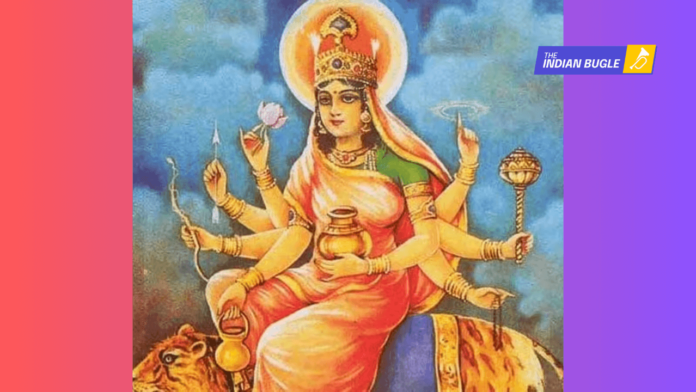Maa Kushmanda is the fourth form of Goddess Durga worshipped during Navratri. Her name roughly means “the one with a little smile that illuminated the universe.” She is believed to have created the cosmos with her smile and is worshipped for health, wealth, energy, and the power to overcome darkness. Her presence is calming — she blesses devotees with strength, bright beginnings, and inner warmth.
Maa Kushmanda is often depicted as a radiant and smiling Goddess, symbolizing warmth and creation. She is shown seated on a lion, which represents courage and strength. The Goddess has eight hands (Ashtabhuja) holding: Kamandalu (water pot), Bow and arrow, Lotus flower, Chakra (discus), Gada (mace), Amrit Kalash (nectar pot), Jap Mala (rosary), One hand in Abhaya Mudra (gesture of blessing and protection).
Her glowing aura is said to be as bright as the sun itself, and her gentle smile is believed to have created the entire universe.
Why Worship Maa Kushmanda? (Quick & Inspiring)
- Brings vitality, energy, and improved health.
- Helps remove darkness — mental confusion, doubt, and negativity.
- Supports students and job-seekers who need focus and new beginnings.
- Invites abundance and inner confidence.
Maa Kushmanda is traditionally worshipped on the 4th day of Navratri. You can perform the puja in the morning (Pratahkal) or in the evening (Sandhya). Pick a quiet time when you won’t be disturbed.
Puja Vidhi — Step-by-Step (Simple, Practical)
Items you’ll need
- Clean altar or small platform, picture/Idol of Maa Kushmanda
- Incense stick (dhoop), lamp (diya) with ghee
- Red and white flowers (see list below)
- Fresh fruit, coconut, betel leaves (paan), sweets (bhog)
- Kumkum (vermillion), haldi (turmeric), chandan (sandal paste)
- Rice grains (akshat), water in a small pot, bell (ghanti), conch (Sankh) (optional)
- A small bowl for offerings and a cloth to keep the altar tidy
Step 1: Clean the altar and take a bath. Lay a clean cloth on the platform and place the idol or picture of Maa Kushmanda facing east or north.
Step 2: Light the lamp and incense. Sit calmly, close your eyes for a few breaths, and invite the Goddess with a short invocation: mentally offer your prayer, asking for protection, health, and clarity.
Step 3: Make a simple promise (sankalpa) aloud: your name, mother/father’s name, and intention for the puja — for example: “I pray for health and success” — then ring the bell softly.
Step 4: Offer Kumkum and haldi, Fruit, and bhog — place cooked offering before the Maa. Light the Diya while singing or reciting the mantra. Ring the Ghanti.
Now do the Durga Saptashati Path according to your comfort.
Step 5: Chant the Kushmanda mantra (see section below). Keep your focus on the breath and the Goddess.
Step 6: Prasad & Conclusion
After the aarti, distribute the bhog as prasad among family members. Touch the altar with folded hands and end with a short prayer of thanks.
Simple Mantras to Recite (Transliteration + Meaning)
- Short Invocation (Beginner-friendly)
Om Sri Maha Kushmandayai Namah.
— “Salutations to the great Goddess Kushmanda.” - Beej (Seed) Mantra — for energy & removal of obstacles
Om Hreem Kleem Kushmandayai Namah.
— A concise, energetic chant invoking strength and blessings. - Longer Chant (for focused chanting)
Om Aim Hreem Kleem Chamundaye Viche Namah.
— A blended chant that calls for divine protection, energy, and spiritual power.
Tip: Chant slowly, with full attention. Even a short, sincere chant is more powerful than long, mechanical repetitions.
Now perform Aarti. If you don’t know the Aarti, follow this Youtube Channel
Tips for a Meaningful Puja
- Cleanliness and sincerity matter more than elaborate items.
- Use fresh offerings; stale items are best avoided.
- If chanting is new to you, play a soft Kushmanda aarti and follow along.
- Keep the atmosphere calm: soft music, minimal phone disturbance, and family participation add warmth.
- If short on time, perform a small prayer with lamp, flower, and mantra — devotion is what counts.
Final Blessing (Short Prayer You Can Use)
“May Maa Kushmanda fill our lives with light, energy, and new beginnings. May she remove fear and bless us with health, focus, and courage. Jai Maa Kushmanda.”
